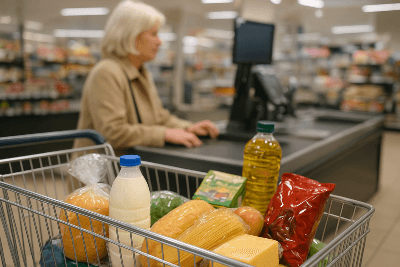Shoppers in the UK are being told food inflation is easing. Government figures this week showed the slowest pace of grocery price rises in two years, with supermarkets keen to promote cuts on milk, bread, and pasta.
But talk to anyone leaving a checkout, and the story isn’t quite so simple. While some staples have dropped back, others are stubbornly climbing — leaving shoppers caught between headlines that promise relief and receipts that suggest otherwise.
The headline numbers
The Office for National Statistics (ONS) said food inflation in July eased to 3.8%, the lowest since early 2022. That compares to double-digit rises through much of last year. Tesco, Sainsbury’s, and Asda have all highlighted reductions on what they call “hero items” — basics such as milk, pasta, and bread.
Tesco’s £1.25 four-pint milk is now cheaper than it was 18 months ago, while Asda says its “price lock” covers more than 600 everyday items.
But averages hide the detail. ONS data also shows sharp rises in categories that rarely make it into supermarket advertising.
What’s still going up
- Chocolate and sweets: With cocoa prices at record highs — almost triple 2021 levels — manufacturers have pushed through rises that shoppers now feel on the shelves.
- Olive oil: A poor harvest in Spain, hit by heatwaves and drought, has left supplies tight. Prices are up nearly 30% year-on-year.
- Frozen ready meals: Convenience foods continue to edge higher, driven by stubbornly high energy costs.
- Fruit juice: Orange juice futures have surged after weather damage in Brazil and Florida. Supermarket own-labels that once sold for £1 now edge closer to £1.50.
In short, the “big four” chains trumpet a cheaper basket of bread and milk — but a night in with chocolate and juice costs more.
Why this matters for shoppers
The selective easing leaves shoppers with a mixed reality. One week, headlines celebrate falling inflation. The next, families discover their favourite treats or cooking staples are dearer than ever.
It is here that supermarket strategy plays out. Retailers choose which products become price signals — the items most visible to families and most often compared across chains. Milk, pasta, and bread fit that role. Olive oil or chocolate do not.
For households, that gap is confusing. As one shopper told GSN in London’s Holloway Road this week: “I keep hearing prices are falling, but every time I buy olive oil or orange juice, it feels worse. What’s the point of the statistics if they don’t match my bill?”
A battle of trust
Industry analysts argue this perception gap could become a problem for supermarkets. Shoppers might begin to distrust messaging that leans too heavily on headline inflation.
“Hero items are real,” said one retail analyst, “but they can also be a smokescreen. If supermarkets lean too far into selective cuts, they risk shoppers noticing the stealth rises elsewhere.”
This tension feeds directly into the value war now raging. Lidl and Aldi continue to press their everyday low-price promise, while Asda invests in its price lock. Tesco and Sainsbury’s counter with loyalty card discounts. Each model tries to convince shoppers that their basket is the cheapest — even if the reality varies by what you buy.
The bigger picture: UK vs Europe
The UK’s easing contrasts with parts of Europe, where food inflation is still running higher. Eurostat data shows eurozone food prices up 5.4% in July, with olive oil alone up more than 40% across Spain and Italy.
For import-heavy Britain, that global pressure matters. Many of the products still rising are precisely those the UK relies on imports for: olive oil, cocoa, fruit juice. Domestic milk and bread, by contrast, are easier for supermarkets to discount without hurting margins.
GSN analysis
Inflation headlines can be misleading. An average basket may look cheaper on paper, but real household experience depends on what goes into it. Families who rely heavily on basics might feel some relief. Families who buy more imported goods feel the opposite.
That gap — between the statistical easing and the lived reality — will define supermarket trust this autumn. If chains oversell “falling prices” while shoppers still see rising bills, the backlash could be real.
For now, inflation is technically falling. But at the tills, the story remains far more complicated.



